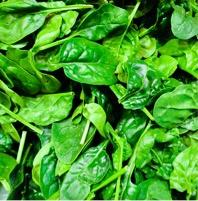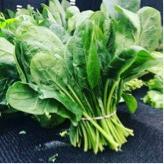Spinach
-
Scientific NameSpinacia oleracea
-
General Information
 Photo: Nathan Nugent/UnsplashSpinach (Spinacea oleracea) is a cool-season annual crop that matures quickly. It's eaten raw or cooked and is packed with vitamins and minerals. Spinach produces a rosette of leaves that may be wrinkled (savoy or semisavoy types) or smooth (flat leaf types). Leaves are oval, round, or triangular on short stems. Baby spinach is simply immature leaves.
Photo: Nathan Nugent/UnsplashSpinach (Spinacea oleracea) is a cool-season annual crop that matures quickly. It's eaten raw or cooked and is packed with vitamins and minerals. Spinach produces a rosette of leaves that may be wrinkled (savoy or semisavoy types) or smooth (flat leaf types). Leaves are oval, round, or triangular on short stems. Baby spinach is simply immature leaves. Photo: Elianna Friedman, Unsplash
Photo: Elianna Friedman, Unsplash -
When to Plant
The ideal temperature for growth is 40° to 75° F and is most rapid at 60° to 65° F. Spinach can tolerate temperatures of 15° to 20° F without injury. However, freezing temperatures can harm small seedlings and plants at maturity. Intermediate-size plants can handle subfreezing temperatures for weeks.
Spinach is usually seeded in place February through March (and into April and May in cooler climates.) Seed again and or plant starts in September and harvest before cold weather slows growth.
-
Planting
Several weeks prior to planting, amend planting bed with compost or a planting mix for raised beds. Direct seeding is preferred. Sprinkle seed over a two to four inch wide band about a half inch deep, and cover lightly with soil. Thin to three to four inches apart when seedlings are two inches high. Use scissors at the soil line so as to not disturb the roots of plants chosen to remain. Because spinach is fast growing and short-lived, sow every two to three weeks for a continuous harvest. If container gardening, plant spinach in a pot that is at least eight inches deep.
Spinach does best in full sunlight (at least four to six hours a day). Plant spinach in a well-exposed area in the garden where it is not shaded by trees, fences, or walls. Try to plant away from areas that will be watered by lawn sprinklers.
Whenever possible, select a location that is not heavily infested with weeds. Also avoid areas that have had previous disease problems.
Some light shade from taller plants in a succession garden is advisable if planted mid-spring or late-summer/early-fall, as this time can be quite warm in some parts of Marin.
-
Soil Requirements
Spinach does best in well-drained soils with pH of 6.0 to 6.5. Damp soil surfaces encourage snails, slugs, sow bugs, and root diseases; fruit decay and leaf spot diseases may also increase. Adding organic matter (compost, peat moss, ground dry leaves and needles) makes clay and sandy soils lighter in texture, more fertile, and increases drainage capacity. Lime or gypsum may be added to soils low in calcium.
-
Water Requirements
Spinach has a shallow root system and does best with frequent, even shallow irrigation. Keep the soil moist, but not wet. Ideally, it is best to irrigate with sprinklers to get the crop up from seed, but then switch to drip irrigation to avoid too much moisture on the leaves. Avoid saturated soil conditions, which favor the development of crown and lower leaf rot.
-
Fertilizing
Because spinach is a fast-growing crop, if beds are properly amended prior to planting, no additional fertilizer will be needed. The moist soil and nitrogen-rich amendments will encourage leaves to grow quickly so that they are tender at harvest.
-
Pollination
Spinach is harvested before pollination. When left to go to flower, spinach is wind-pollinated, meaning insects are not required for pollination. Once the male stamens are full of pollen, the wind blows it onto the females and fertilizes them.
-
Harvesting
Spinach can be harvested when leaves reach four to six inches tall and there are at least eight leaves on the plant. Whole plants can be harvested at once; cut at the base. Outer leaves can be picked off, which allows for one or more additional harvests.
-
Storage
After harvest, wash, and store in the refrigerator in the crisper drawer. Spinach can be stored up to two weeks at 32°F and 95% relative humidity. Spinach also freezes well.
-
Good Varieties for Marin
Savoy has crisp, crinkly leaves and a firm texture that stands up to cooking or may be eaten fresh. Plant ‘America’ or ‘Winter Bloomsdale’.
Semi-savoy is less crinkly and is preferred by some because it’s easier to clean. Plant ‘Tyee,’ ‘Space,’ or ‘Melody Hybrid’.
Flat leaf has large smooth leaves, is more tender than the curly variety, and is often eaten fresh. Plant ‘Olympia’ or ‘Grant Nobel’.
-
Helpful Tips
Do not wait too long to harvest as larger leaves can taste bitter and the plant may bolt (flower).
-
Common Problems
Leafminers: Check the underside for eggs and crush them before they hatch. Destroy leaves when you see their burrows. Plant flowers close by to attract parasitic wasps that eat leaf miners, and/or plant radishes that may distract the leaf miners from the spinach.
Aphids: Hose off.
Loopers, slugs, and snails: Hand pick.
-
Pests- Diseases & More
Learn more about growing spinach.


